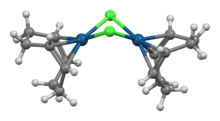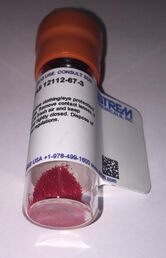Chemistry:Cyclooctadiene iridium chloride dimer

| |

| |

| |
| Names | |
|---|---|
| Other names
Bis(1,5-cyclooctadiene)diiridium(I) dichloride
| |
| Identifiers | |
3D model (JSmol)
|
|
| ChemSpider | |
| EC Number |
|
PubChem CID
|
|
| |
| Properties | |
| C16H24Cl2Ir2 | |
| Molar mass | 671.70 |
| Appearance | red-orange solid |
| Density | 2.65 g/cm3 (red polymorph) |
| Hazards | |
| GHS pictograms | 
|
| GHS Signal word | Warning |
| H302, H312, H315, H319, H335 | |
| P261, P264, P270, P271, P280, P301+312, P302+352, P304+340, P305+351+338, P312, P321, P322, P330, P332+313, P337+313, P362, P363, P403+233, P405, P501 | |
Except where otherwise noted, data are given for materials in their standard state (at 25 °C [77 °F], 100 kPa). | |
| Infobox references | |
Cyclooctadiene iridium chloride dimer is an organoiridium compound with the formula [Ir(μ2-Cl)(COD)]2, where COD is the diene 1,5-cyclooctadiene (C8H12). It is an orange-red solid that is soluble in organic solvents. The complex is used as a precursor to other iridium complexes, some of which are used in homogeneous catalysis.[1] The solid is air-stable but its solutions degrade in air.
Preparation, structure, reactions
The compound is prepared by heating hydrated iridium trichloride and cyclooctadiene in alcohol solvent. In the process, Ir(III) is reduced to Ir(I).[2]
In terms of its molecular structure, the iridium centers are square planar as is typical for a d8 complex. The Ir2Cl2 core is folded with a dihedral angle of 86°. The molecule crystallizes in yellow-orange and red-orange polymorphs; the latter one is more common.[3][4]
The complex is widely used precursor to other iridium complexes. A notable derivative is Crabtree's catalyst.[5] The chloride ligands can also be replaced with methoxide to give cyclooctadiene iridium methoxide dimer, Ir2(OCH3)2(C8H12)2.[6] The cyclooctadiene ligand is prone to isomerize in cationic complexes of the type [(C8H12)IrL2]+.[7]
See also
References
- ↑ J. Hartwig, "Organotransition Metal Chemistry: From Bonding to Catalysis" University Science Books, 2009. ISBN:978-1891389535.
- ↑ Herdé, J. L.; Lambert, J. C.; Senoff, C. V. (1974). "Cyclooctene and 1,5-Cyclooctadiene Complexes of Iridium(I)". Inorganic Syntheses. Inorganic Syntheses. 15. p. 18–20. doi:10.1002/9780470132463.ch5. ISBN 9780470132463.
- ↑ F. Albert Cotton, Pascual Lahuerta, Mercedes Sanau, Willi Schwotzer "Air oxidation of Ir2(Cl)2(COD)2 revisited. The structures of [Ir(μ2-Cl)(COD)]2 (ruby form) and its oxidation product, Ir2Cl2(COD)2(μ2-OH)2(μ2-O)" Inorganica Chimica Acta, 1986 vol. 120, Pages 153–157. doi:10.1016/S0020-1693(00)86102-2
- ↑ Tabrizi, D., Manoli, J. M., Dereigne, A., "Etude radiocristallographique de μ-dichloro-bis (π cyclooctadiène-1,5) diiridium: [(COD-1,5)IrCl]2, variété jaune-orange", Journal of the Less Common Metals 1970, vol. 21, pp. 337. doi:10.1016/0022-5088(70)90155-4
- ↑ Crabtree, Robert H.; Morehouse, Sheila M. (1986). "[η4 -1,5-Cyclooctadiene)(Pyridine)-(Tricyclohexylphosphine)Iridium(I)Hexafluorophosphate". [η4-1,5-Cyclooctadiene)(Pyridine)(Tricyclohexylphosphine)Iridium(I)Hexafluorophosphate. Inorganic Syntheses. 24. p. 173–176. doi:10.1002/9780470132555.ch50. ISBN 9780470132555.
- ↑ Uson, R.; Oro, L. A.; Cabeza, J. A. (1985). Dinuclear Methoxy, Cyclooctadiene, and Barrelene Complexes of Rhodium(I) and Iridium(I). Inorganic Syntheses. 23. pp. 126–130. doi:10.1002/9780470132548.ch25. ISBN 9780470132548.
- ↑ Martín, Marta; Sola, Eduardo; Torres, Olga; Plou, Pablo; Oro, Luis A. (2003). "Versatility of Cyclooctadiene Ligands in Iridium Chemistry and Catalysis". Organometallics 22 (26): 5406–5417. doi:10.1021/om034218g.
 |
